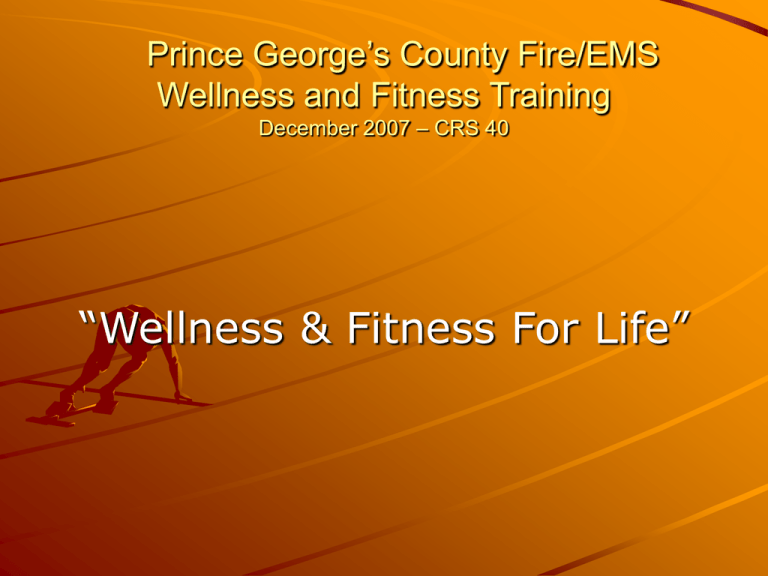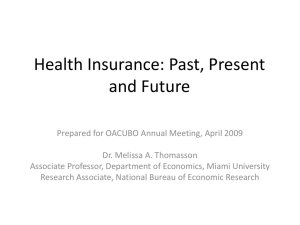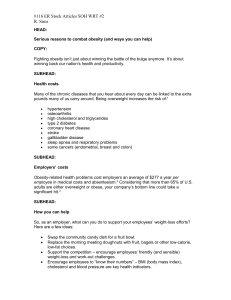Physical Fitness Guide
advertisement

Prince George’s County Fire/EMS Wellness and Fitness Training December 2007 – CRS 40 “Wellness & Fitness For Life” Unacceptable Average Life Expectancy 66 Problems Adjusting to “Abnormal Culture” vs. “Normal World” The National and Departmental “Cultural Attitude” Towards Wellness and Fitness Health Care System Policy and Procedure Failure Rate of Programs Alcoholism/substance abuse Addictive/Extreme behaviors Psychological Stress of the public safety officer Physiological Stress of the public safety officer Departmental Bureaucracy Organizational and Individual Workload Recruitment and Hiring Process Economics Public Safety Typical Personality Profile – – – – – – – Perfectionist Driven to succeed Willing to work long and irregular hours Ideals of individual service and sacrifice Independent/ self reliant Tendency to be a “risk taker” “Adrenalin Junkies” “Wellness” - Defined Physical Emotional Spiritual Dimensions Of Wellness Career Family Financial Social “Tip of the Spear” Health risk factors: Uncontrollable factors - Increasing age - Sex (gender) - Hereditary (including race) Controllable and/or treatable by changing lifestyle or medicine - Abnormal lipid profile (Cholesterol) Hypertension Obesity (Increase BMI, >30 lbs overweight) Sedentary lifestyle Smoking Diabetes Poor nutrition Cardiac Risk Factor Profile American College of Sports Medicine Risk Stratification The Risk Factors • Age • Family Cardiac History • • • • • • *Abnormal Cholesterol Levels *High Blood Pressure *Obesity *Sedentary Lifestyles *Smoking *Diabetes *Identified as primary risk factors by American Heart Association Controllable Risk Factor Defining Criteria -Male > 45 years old -Female > 55 years old Age Risk Factor Family History Defining Criteria -Male = Heart attack or sudden death before age 55 of father, brother, or son. -Female = Heart attack or sudden death before age 65 of mother, sister or daughter. Risk Factor Hyper-Cholesterolemia Defining Criteria -Total serum cholesterol is > 200 mg/dL -HDL (high density lipid) “good” cholesterol is < 40 mg/dL -LDL (low density lipid) “bad” cholesterol is > 130 mg/dL -Currently on cholesterol medication. **Note: Negative Risk factor if HDL is > 60 mg/dL** Good, Bad, and Ugly Cholesterol “GOOD” High Density Lipids (HDL) Good, Bad, and Ugly Cholesterol “Bad” Low Density Lipids (LDL) Good, Bad, and Ugly Cholesterol “Ugly” Total Cholesterol > 200 High Density Lipids (HDL) < 40 Coronary Risk Ratio > 5.0 Good, Bad, and Ugly Cholesterol “Ideal” Total Cholesterol < 200 High Density Lipids (HDL) > 40 Coronary Risk Ratio < 5.0 **Negative Risk factor if HDL is > 60** Risk Factor Hypertension Defining Criteria -Systolic blood pressure > 140 mmHg -Diastolic > 90 mmHg -Confirmed on at least two separate readings. -Currently on high blood pressure medication. What are High Blood Pressure Risks? Likelihood of cardiovascular event by the chronic hypertensive numbers…… 115/75…………………………….Normal 135/85……………………………. 3X 155/95……………………………. 4X 175/105………………………….. 8X *National Heart, Lung & Blood Institute Risk Factor Obesity Defining Criteria -Body Mass Index > 30 ~ 30lbs over ideal weight -Male waist girth > 40 inches -Female waist girth > 35 inches *Use clinical judgment when evaluating obesity and BMI Obesity CAN CAUSE Premature death Cardiovascular Disease High Blood Pressure Osteoarthritis Some Cancers Diabetes PATTERNS Abnormal lipid profile (Cholesterol) Sedentary lifestyle Poor nutrition Obesity Diabetes Hypertension Smoking Obesity Trends Among U.S. Adults between 1985 and 2006 Source of the data: The data shown in these maps were collected through CDC’s Behavioral Risk Factor Surveillance System (BRFSS). Each year, state health departments use standard procedures to collect data through a series of monthly telephone interviews with U.S. adults. Prevalence estimates generated for the maps may vary slightly from those generated for the states by BRFSS (http://aps.nccd.cdc.gov/brfss) as slightly different analytic methods are used. Obesity Trends* Among U.S. Adults BRFSS, 1985 (*BMI ≥30, or ~ 30 lbs. overweight for 5’ 4” person) No Data <10% 10%–14% Obesity Trends* Among U.S. Adults BRFSS, 1986 (*BMI ≥30, or ~ 30 lbs. overweight for 5’ 4” person) No Data <10% 10%–14% Obesity Trends* Among U.S. Adults BRFSS, 1987 (*BMI ≥30, or ~ 30 lbs. overweight for 5’ 4” person) No Data <10% 10%–14% Obesity Trends* Among U.S. Adults BRFSS, 1988 (*BMI ≥30, or ~ 30 lbs. overweight for 5’ 4” person) No Data <10% 10%–14% Obesity Trends* Among U.S. Adults BRFSS, 1989 (*BMI ≥30, or ~ 30 lbs. overweight for 5’ 4” person) No Data <10% 10%–14% Obesity Trends* Among U.S. Adults BRFSS, 1990 (*BMI ≥30, or ~ 30 lbs. overweight for 5’ 4” person) No Data <10% 10%–14% Obesity Trends* Among U.S. Adults BRFSS, 1991 (*BMI ≥30, or ~ 30 lbs. overweight for 5’ 4” person) No Data <10% 10%–14% 15%–19% Obesity Trends* Among U.S. Adults BRFSS, 1992 (*BMI ≥30, or ~ 30 lbs. overweight for 5’ 4” person) No Data <10% 10%–14% 15%–19% Obesity Trends* Among U.S. Adults BRFSS, 1993 (*BMI ≥30, or ~ 30 lbs. overweight for 5’ 4” person) No Data <10% 10%–14% 15%–19% Obesity Trends* Among U.S. Adults BRFSS, 1994 (*BMI ≥30, or ~ 30 lbs. overweight for 5’ 4” person) No Data <10% 10%–14% 15%–19% Obesity Trends* Among U.S. Adults BRFSS, 1995 (*BMI ≥30, or ~ 30 lbs. overweight for 5’ 4” person) No Data <10% 10%–14% 15%–19% Obesity Trends* Among U.S. Adults BRFSS, 1996 (*BMI ≥30, or ~ 30 lbs. overweight for 5’ 4” person) No Data <10% 10%–14% 15%–19% Obesity Trends* Among U.S. Adults BRFSS, 1997 (*BMI ≥30, or ~ 30 lbs. overweight for 5’ 4” person) No Data <10% 10%–14% 15%–19% ≥20% Obesity Trends* Among U.S. Adults BRFSS, 1998 (*BMI ≥30, or ~ 30 lbs. overweight for 5’ 4” person) No Data <10% 10%–14% 15%–19% ≥20% Obesity Trends* Among U.S. Adults BRFSS, 1999 (*BMI ≥30, or ~ 30 lbs. overweight for 5’ 4” person) No Data <10% 10%–14% 15%–19% ≥20% Obesity Trends* Among U.S. Adults BRFSS, 2000 (*BMI ≥30, or ~ 30 lbs. overweight for 5’ 4” person) No Data <10% 10%–14% 15%–19% ≥20% Obesity Trends* Among U.S. Adults BRFSS, 2001 (*BMI ≥30, or ~ 30 lbs. overweight for 5’ 4” person) No Data <10% 10%–14% 15%–19% 20%–24% ≥25% Obesity Trends* Among U.S. Adults BRFSS, 2002 (*BMI ≥30, or ~ 30 lbs. overweight for 5’ 4” person) No Data <10% 10%–14% 15%–19% 20%–24% ≥25% Obesity Trends* Among U.S. Adults BRFSS, 2003 (*BMI ≥30, or ~ 30 lbs. overweight for 5’ 4” person) No Data <10% 10%–14% 15%–19% 20%–24% ≥25% Obesity Trends* Among U.S. Adults BRFSS, 2004 (*BMI ≥30, or ~ 30 lbs. overweight for 5’ 4” person) No Data <10% 10%–14% 15%–19% 20%–24% ≥25% Obesity Trends* Among U.S. Adults BRFSS, 2005 (*BMI ≥30, or ~ 30 lbs. overweight for 5’ 4” person) No Data <10% 10%–14% 15%–19% 20%–24% 25%–29% ≥30% Obesity Trends* Among U.S. Adults BRFSS, 2006 (*BMI ≥30, or ~ 30 lbs. overweight for 5’ 4” person) No Data <10% 10%–14% 15%–19% 20%–24% 25%–29% ≥30% Risk Factor Sedentary Lifestyle Defining Criteria -Persons not participating in regular exercise program. -Persons not accumulating 30 minutes of moderate physical activity at least 4 – 7 days per week. Durable and Multi-Disciplined Muscular Strength The ability to exert a maximal force at a given speed in a single voluntary contraction. Muscular Endurance The ability to exert a sub-maximal force for voluntary contractions or one extended contraction. Public Safety Fitness Cardio-Pulmonary Endurance The ability of the heart and lungs to deliver oxygen to working muscles for extended periods of time. Flexibility The ability to have a range of motion at a joint and/or spine. Risk Factor Tobacco Use Defining Criteria -Current tobacco user of any type (cigarette, cigar, pipe, chewing tobacco) -Tobacco user that has quit within last 6 months. Risk Factor Diabetes Defining Criteria -Physician diagnosed diabetes (insulin, diet or exercise controlled) Is there something on your six? A Healthy Stress Pattern Excited Relaxed Uh Oh! Normal Ah! A Unhealthy Stress Pattern Excited Uh Oh! Uh Oh! Breakdown Relaxed Uh Oh! Commonly Used Maladaptive Coping Techniques Harder, Faster, Better Hyper-Activity Impulsive and Reckless Behavior w/o Thought Substance Abuse PURSUIT OF OUTSIDE INTERESTS/ HOBBIES DIET Longevity The Centenarian Personality* What can you learn from 100 year old people? Never Smoked Sense Of Humor Sense Of Hope Not Obese Centenarian >100 years Willing To Engage Healthy Coping Mechanisms No Major Illnesses Practices Stress Reduction *Information taken from “Aging Smart…Aging Well” Monika White, PhD, President/CEO Center for Healthy Aging, March 2006 Take Home Message Take Home Message Take personal responsibility for your Wellness Take Home Message Take personal responsibility for your Wellness Avail yourself of Proper Resources Take Home Message Take personal responsibility for your wellness Avail yourself of proper resources Establish & practice good habits FOR MOST OF US…. FOR MOST OF US…. CHANGE ISN’T EASY Thanks For questions & comments cdbussing@co.pg.md.us








